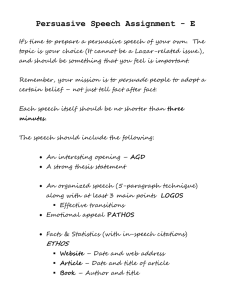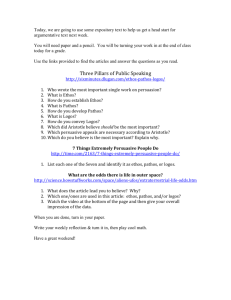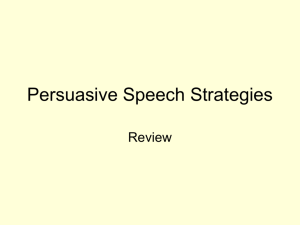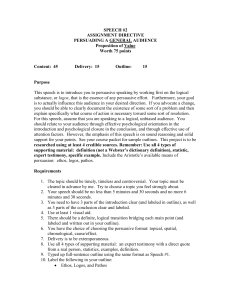sample assignment Public Speaking + Invisible Man
advertisement
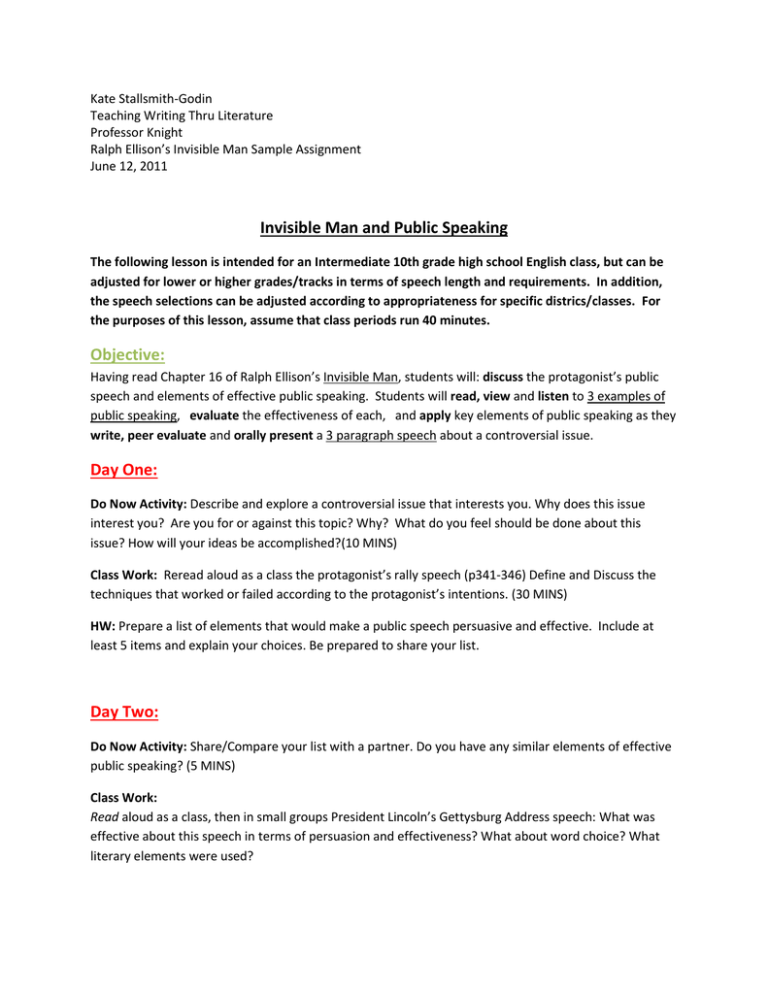
Kate Stallsmith-Godin Teaching Writing Thru Literature Professor Knight Ralph Ellison’s Invisible Man Sample Assignment June 12, 2011 Invisible Man and Public Speaking The following lesson is intended for an Intermediate 10th grade high school English class, but can be adjusted for lower or higher grades/tracks in terms of speech length and requirements. In addition, the speech selections can be adjusted according to appropriateness for specific districs/classes. For the purposes of this lesson, assume that class periods run 40 minutes. Objective: Having read Chapter 16 of Ralph Ellison’s Invisible Man, students will: discuss the protagonist’s public speech and elements of effective public speaking. Students will read, view and listen to 3 examples of public speaking, evaluate the effectiveness of each, and apply key elements of public speaking as they write, peer evaluate and orally present a 3 paragraph speech about a controversial issue. Day One: Do Now Activity: Describe and explore a controversial issue that interests you. Why does this issue interest you? Are you for or against this topic? Why? What do you feel should be done about this issue? How will your ideas be accomplished?(10 MINS) Class Work: Reread aloud as a class the protagonist’s rally speech (p341-346) Define and Discuss the techniques that worked or failed according to the protagonist’s intentions. (30 MINS) HW: Prepare a list of elements that would make a public speech persuasive and effective. Include at least 5 items and explain your choices. Be prepared to share your list. Day Two: Do Now Activity: Share/Compare your list with a partner. Do you have any similar elements of effective public speaking? (5 MINS) Class Work: Read aloud as a class, then in small groups President Lincoln’s Gettysburg Address speech: What was effective about this speech in terms of persuasion and effectiveness? What about word choice? What literary elements were used? Listen to Martin Luther King’s speech (excerpt): What was effective about this speech in terms of persuasion and effectiveness? How was experiencing this speech different from the first? How is voice and tone important in effectively presenting a speech? What literary elements were used? View President Obama’s Inauguration speech: What was effective about this speech in terms of persuasion and effectiveness? How was experiencing this speech different from the first two? How is body language, gesture and eye contact important in effective communication of a speech? (30 MINS- approx 10 mins each) Day Three: Individual Work: Computer Lab: Use the internet to research your controversial topic. You will be using any information you find to write a 3 paragraph persuasive speech about your topic. You may wish to include logos, ethos or pathos in your argument. You should have a minimum of 4 sources to include in your speech. HW: Use your 2 Do Now Activities (controversial issue, and list of effective elements of speech) and your research to write a 3 paragraph rough draft of a speech speaking about the issue you explored. In your speech include examples if the following elements found in Invisible Man: parallelism, imagery, onomatopoeia, metaphor, enunciation and logos, ethos, pathos (from your research). Consider the word choice in your writing. Think about how you wish to open and close your speech. Bring 3 copies to class and Be prepared to share in small groups. Day Four: Group Work: In small groups of 3: read your speech aloud to your group. They will give you feedback on the effectiveness of your speech in terms of voice, word choice, , clarity and overall effective use of literary elements using a rubric. (20 MINS) Class Work: You will watch stand-up comedian Sinbad’s video clip. Discuss the importance of timing/voice/ body language in public speaking. (10 MINS) Day Five: Revise rough draft and read aloud for timing, body language, and voice. Be prepared to orally present speech to the class. Day Six: Do Now Activity: Prep for presentation (5 MINS) Individual Presentations: You will be graded by rubric. Turn in speech with peer evaluation rubrics and rough draft. (30 MINS) *Depending on # of students, two days may be required for presentations. *See Peer Evaluation Rubric Below: Peer Evaluation Rubric: Rally Speech Rough Draft Author’s Name:____________________________ Editor’s Name:_______________________________ Criteria 3=Excellent 2=Fair 1=Needs Improvement Use of literary elements: speech should include effective examples of all required elements: parallelism, imagery, onomatopoeia, metaphor Research: Evidence of research in the form of logos, ethos, pathos Voice: Maintains a strong, clear, persuasive tone Eye Contact/ Body Lang: Maintains effective eye contact, uses appropriate gesture Overall Persuasiveness: Has persuaded audience to entertain perspective Constructive Comments: write about 1 thing that was effective and 1 thing that needs improvement, or you would like to hear more of: *Have you been persuaded? Why/ Why Not? What could be changed/added? Evaluation: out of 15 points Invisible Man Sample Assignment Rationale Lesson Level and Placement: Throughout the Ellison’s novel, Invisible Man, the protagonist makes several public speeches. I have chosen to use this element of oral communication for the basis of a mini writing-speaking lesson. This is a lesson that I would incorporate in a unit on persuasive argument. This unit would be ordered in a tier of activities that would enhance understanding and strengthen skills in writing and speaking. This unit would begin with an introduction to Aristotle’s Elements of Persuasive Argument, which include logos, ethos and pathos. Students would apply these terms by writing and performing a commercial after analyzing these techniques in several commercial examples. Having been introduced to these elements, students would then apply these ideas in the following lesson on persuasive speech. Following these two activities, students would then apply effective techniques by writing a 7-10 page research paper. Reflection: Depending on student ability level, more time can be taken to model, draft and revise. I feel a shorter time limit focuses the student and prevents them from procrastinating; the drawback is that the finished product may be rushed. Teachers should take into account their students’ abilities. Strengths/Justification: This lesson has several levels of strengths in terms of enhancing student skills. First, this lesson meets all NJCCCS, those being reading, writing, speaking, listening, viewing media. It is often extremely difficult to meet all standard requirements, but this lesson incorporates all five standards to strengthen the writing and oral delivery of the finished product. Second, because the speech focuses on the students’ selection, they will have a more vested interest in effectively communicating their ideas. Richard A. Lanham discusses how literature can never be absent from the real world. Today’s teachers are pushed to aid students in making personal connections to literature, and this lesson would certainly allow them to understand the value of public speaking. A third strength of this lesson is incorporating peer evaluation. Both Wayne C. Booth and Fischer et al. reference the importance of oral/written exchanges between students, and how students will become more aware of audience by writing for a group of their peers. The use of an evaluation rubric also allows the class to be guided in constructive responses, before the students perform for each other. A fourth strength of this lesson rests on Corbett’s assertion that observe and imitate is effective in strengthening student writing. In this lesson, students are exposed to a variety of examples of public speaking, examples of both masters and their peers. Additionally, these examples reach multiple intelligences as they read, listen and view effective speeches and discuss them before writing their own speech.
